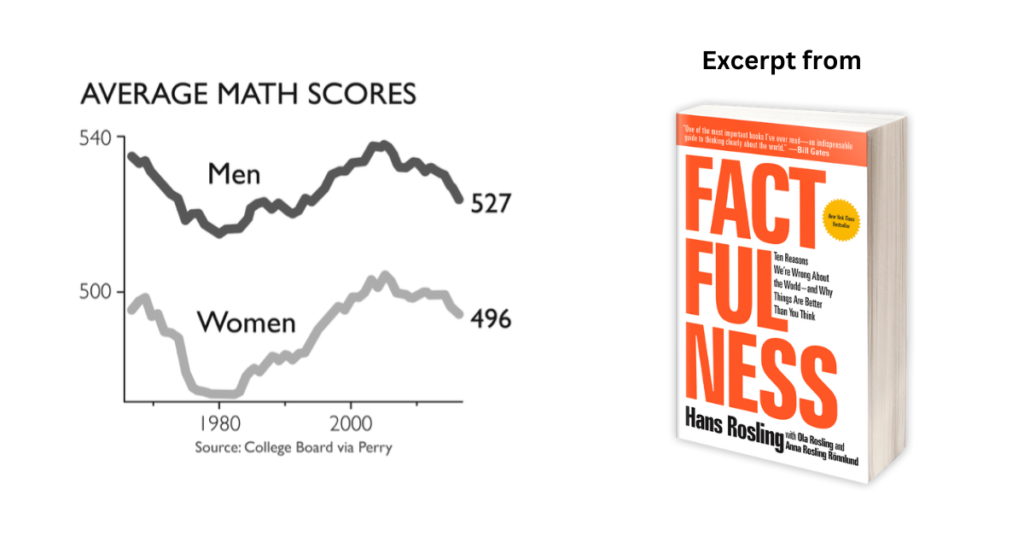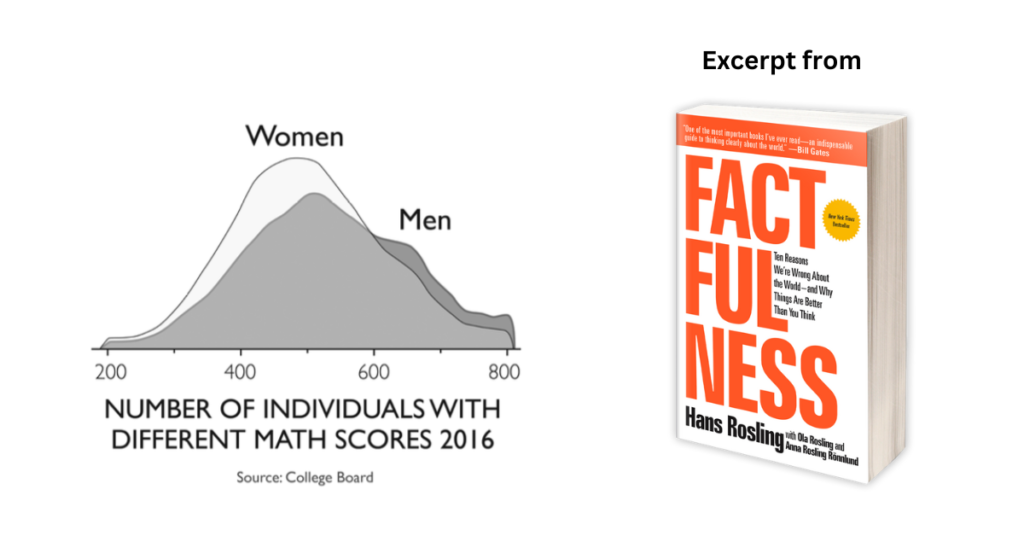THE EFFECTIVE PROBLEMSOLVER #067
In our collective pursuit of a fairer and more equitable society, the imperative to address disparities has emerged as a cornerstone principle.
However, despite our earnest intentions, we frequently find ourselves ensnared by oversimplified narratives, unwittingly magnifying perceived differences between various groups.
In this week’s newsletter, I’ll share the pitfalls of exclusively viewing the world through the narrow lens of disparity, revealing how it distorts reality, perpetuates bias, and hampers the effectiveness of policy solutions.
Then, I’ll introduce a more nuanced perspective—one that unveils a much more detailed picture of reality, as well as insights for how we can pursue effective change.
Let’s dive in.
A Propensity for Seeing Dramatic Gaps
We are bombarded with an abundance of information every day.
However, what we often fail to recognize is that our minds act as filters, automatically processing and interpreting this data through the lens of our own biases and preconceptions.
These mental filters have a propensity to draw dramatic conclusions, sometimes veering far from the nuanced reality that lies beneath the surface.
One of the filters, conceptualized by Hans Rosling as the “gap instinct,” sheds light on our innate tendency to fixate on differences without considering the broader context.
Rosling, who was a pioneer in statistics and public health, recognized that our instinctual focus on disparities is often fueled by the presentation of data in linear graphs.
Whether it’s income, education, or math scores, these graphs paint a stark picture of divergence, highlighting the average difference between groups.
Take, for instance, the widely cited disparity in math scores between men and women.
When presented in a linear graph, it appears as a gaping chasm, reinforcing the notion of inherent differences or wide-spread discrimination.

However, a more holistic truth lies in the details.
Upon closer examination, we discover that the distribution of math scores between men and women is not a gaping chasm at all, but rather a hugely overlapping spectrum.

As changemakers have rushed to create disparity dashboards featuring linear graphs over the last decade (and I’m one of them), I’m reminded of Richard Feynman’s insight into our collective fallibility:
"The first principle is that you must not fool yourself, and you are the easiest person to fool."
Indeed, we often deceive ourselves by fixating on averages – a top-down view comparing just two points – and overlooking the rich tapestry of diversity within each group.
Policy Implications: A Tale of Two Lenses
But it’s not just about data visualization.
As I’ve worked with changemakers around the country, here’s what I’ve noticed:
How people see the problem determines the types of solutions they choose.
Let’s look at how this plays out in real life.
For example, when it comes to addressing disparities in math scores between men and women, two distinct views emerge:
The disparity lens and the distribution lens.
I’ve pursued both over my years of advocacy – but they’re not equally effective.
Let’s delve into the unique perspectives offered by each lens in tackling disparities and shaping policy interventions.
Disparity Lens
The disparity lens fixates exclusively on closing the gap between men and women in math scores.
Policies guided by this lens often funnel resources and interventions solely towards women, aiming to achieve parity with their male counterparts.
However, this binary approach risks perpetuating gender stereotypes and oversimplifying the multifaceted factors contributing to disparate math scores.
By narrowly focusing on gender as the primary determinant, policymakers may overlook critical factors such as socioeconomic status, access to quality education, and individual learning styles.
While the disparity lens highlights differences between groups, it often falls short in addressing disparities meaningfully.
A more intersectional approach is essential to address the complex web of factors contributing to academic inequalities.
Distribution Lens
In contrast, the distribution lens offers a more nuanced understanding of disparities by recognizing the extensive overlap between men and women in math scores.
Rather than fixating on group averages, policies informed by this lens prioritize improving math scores for all individuals falling below a certain threshold, typically the average score.
This approach acknowledges that the distribution of math scores is not neatly divided along gender lines and allocates resources proportionately to individuals underrepresented in terms of their math performance, regardless of gender.
But, crucially, note that more resources would still go to women under this proportionate distribution approach, as they are overrepresented in below-average scores.
By shifting the focus from group identity to individual outcomes, policymakers can effectively target those most in need of support, ensuring a more equitable distribution of resources.
This approach not only mitigates the risk of perpetuating stereotypes associated with group-based solutions but also fosters inclusivity and effectiveness in addressing disparities in math performance.
Shifting the Focus to Individual Outcomes
The distinction between the disparity lens and the distribution lens highlights the critical importance of prioritizing differences in individual outcomes over simplistic group averages when formulating policy interventions.
By embracing a distribution lens approach, policymakers can ensure that resources and interventions are proportionately directed towards those most in need, irrespective of their demographic characteristics.
This approach not only fosters a more equitable and inclusive society but also amplifies the effectiveness of interventions by tackling disparities at the individual level.
In essence, the distribution lens offers a discrimination-free pathway to reducing disparities over the long run.
By tailoring interventions to address the specific needs and circumstances of each individual, policymakers can pave the way for a more just and equitable society where everyone has the opportunity to thrive, regardless of their background or identity.
Guiding Principles for Seeing Nuance
So, how do we navigate this complexity and ensure that our decisions are based on the full picture rather than oversimplified assumptions of extreme difference?
Here are three guiding principles:
#1. Embrace distributions over averages
The world presents a complex tapestry of interconnected variables, where group-based disparities represent merely one thread among many.
It’s imperative to move beyond singular averages and delve into the intricate distributions of data within different groups.
By embracing distributions, we uncover the richness of diversity and the significant overlaps that exist within and between various groups.
This nuanced exploration allows for a deeper understanding of the dynamics at play, enabling more informed and comprehensive decision-making processes.
#2. Question how data presentation shapes our conclusions
Our analysis of data is frequently tainted by our preconceived beliefs and biases, leading us to draw conclusions that reinforce stereotypes and overemphasize the perceived link between immutable characteristics and outcomes.
Challenge these assumptions by rigorously interrogating the data from a variety of angles.
Consider how alternative presentations of data could reshape your understanding and reveal more nuanced insights.
#3. See diversity within groups
Engage with a range of voices and perspectives to enrich your understanding of complex issues.
Recognize that the variation or diversity observed within a particular group (such as a demographic, cultural, or socioeconomic group) is often greater than the differences observed between different groups.
This concept challenges common assumptions about the homogeneity of groups and emphasizes the importance of recognizing individual variation and diversity.
TLDR
We have a tendency to draw dramatic conclusions from filtered data, including oversimplifications that are misleading. (Seek humility).
The antidote is looking for the whole picture, in all its nuance. (Be rigorous).
By seeing more clearly, we can choose more targeted and effective solutions. (Prioritize need, not group identity).
See you next week.
==
Whenever you’re ready, there are two ways I can help you:
→ I’m a strategic advisor for the toughest societal problems like poverty, crime and homelessness. People come to me when they want to stop spinning their wheels and get transformative, systems-level change.
→ I’m a coach for emerging and executive leaders in the social and public sectors who want to make progress on their biggest goals and challenges.
Let’s find out how I can help you become transformational.



